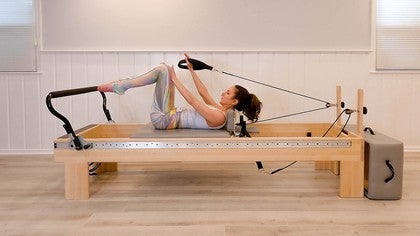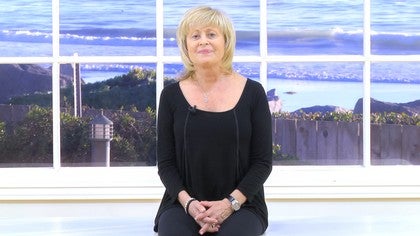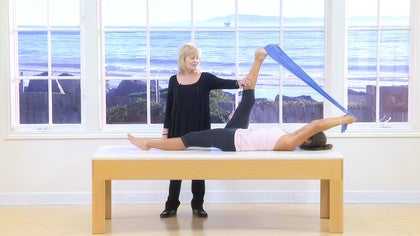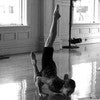Description
About This Video
Transcript
Read Full Transcript
Hi, I'm Mariska. I've been teaching on PilatesAnytime for almost a decade and my very first experience was coming in and teaching a workshop on neuroscience and exercise which is something that's really very personal to me because I've had MS diagnosed for over 20 years now. And so a lot of the people I work with are neurological clients. And then I also work with regular super strong clients. But I think all of us have brains and all of us have our brain and body have adapted in certain ways.
So I wanted to do a workout today that was sort of more focused on the kinds of stuff that I would do with a neuro client or to get somebody to be able to sort of feel how they are compensating in their movements, which we all do because our limbs developed from little buds embryonically and our arms move independently of each other. Our legs move independently of each other. So this entire class is gonna be unilateral with a focus on proprioception. So proprioception is your ability to sort of feel where you are in space. It's like if I lean a little bit to the right I feel heavier in my right side.
If I lean more to the left, I feel heavier in my left side. Most of the time we don't really pay attention to this unless we are specifically drawing our attention to this. So I'll be doing that in this class. Will be a little different from the stuff I normally teach. So we're gonna be doing kind of a long series of leg stuff first.
So something that you can be on for, you know a reasonable period of time. I think I'm gonna go with like a red yellow, 'cause again, it's all gonna be single leg. For your reference, my left leg is my MS affected leg. So I have a lot of muscle tightness in that side and I also have a little bit of paralysis and my left foot has something called foot drop. So my left foot doesn't dorsey flex well and I can't dorsey flex it to 90 degrees.
So because I'm actually drawing attention to that in this class. Like I will talk about like what's happening in my body which probably won't be happening in your body, but just if you're working with clients who have neurological issues stuff to be looking for. So we're just gonna come to lying down on the reformer, kind of like normal. And my right side is my good side and my left side is my MS affected side. And so I'll just be on my heel and I'll have my left leg floating in the air.
Now I wanna feel evenly heavy in this my sacrum on both sides. And then see if I can press out and in and not change how that feels. What you might find is if your leg is going all the way straight maybe you're having a little hip shift. So maybe when your leg is going all the way straight you feel like your hips are moving a little bit to the right or to the left and just you know, pay attention to it first and then see if you can not do that. So you wanna keep the pressure even the entire time.
Now what if I take my left leg and open it out a little bit? Logically you're gonna start to feel heaviness on the left side of your pelvis but what we wanna do is move your leg only so much that that movement isn't rocking your hips from side to side so that you can control that movement. A big thing that we teach when we're working with clients with any kind of like movement deficit is that you need to have stability to have mobility. So an affected limb might actually not be the problem when somebody's moving. It might be that the non-affected limb is not stabilizing well.
So you can bring your hand onto your hip to see if that helps. For me, that makes me feel more grounded. But we also find stability, you know through our spine. We find stability through our lat-glute connection. So you can even sometimes find more stability if you are bringing a hand to your shoulder.
So just kind of play around with how that feels. Now I wanna see if like how it feels to extend my leg and bring it in. Can I bring it in to 90 degrees without changing how the pressure feels on my sacrum? I feel like I can do that, but can I bring it in past 90 degrees? So when I'm coming past 90 degrees, the pressure changes on my sacrum because what's actually happening is I'm coming into a tiny, like tiniest little bit of a posterior pelvic tilt.
And when I'm coming into that little posterior pelvic tilt what's happening is my low back is more pressing into the floor or into the mat. So I'm gonna go ahead and switch to, this is my MS affected side. So for me to do this exercise, if I was on my toes on this side, my leg would shake a lot, which is why I chose to do heel. So I'll press out and when I press out on this side the first thing I notice is that my leg wants to drop in a little bit and that's a problem with weakness in my outer hip on this side, which I know I have. So I'm really concentrating then on keeping the pressure the same, having my knee just feel like it's reaching up towards the ceiling.
So you can also use like a visual cue. So it's like my knee is going to the same spot each time. Then you can open your leg out and bring it back in. Now on this side, I actually feel like even though this is my MS affected leg, I actually can stabilize a little bit better in this motion than I could on the other side. So I actually have the ability to take my right leg a little bit further out without feeling a change in the pressure in my sacrum.
Again, you can bring your hand to your hip. You can bring your hand to the same side hip. That makes it worse. So for me. It might make it better for you.
This is really about figuring out what kind of works for you. One thing I like to do if my leg wants to roll in is just to have my hand on the outside of my leg just reminding it to stay out here and not to go in there and press out, reach the other leg, bring it in. So I'm hitting about 90 without issue. And I can bring this side in further without coming into that posterior pelvic tilt. So again, just paying attention to kind of how things feel.
So right now this is closed chain. So closed chain, my foot is attached to something. It's going to be easier because it's more stable. There's more points of contact where things are fixed. So my torso is fixed on the mat, my foot is fixed on the foot bar, but we're gonna make it a little bit harder now by making it a semi-closed chain which would be using a strap.
So I'm gonna bring a strap onto my right foot. I'm just gonna bring my left leg up and I'm not trying to like, you know, make this hard I just wanna see what it feels like to press my leg down and lift it up trying not to change how it feels in my sacrum. So my range is about this. I could have my leg come in further but when I come in here what has changed is I feel more of my low back. So I'm trying to keep that feeling of my sacrum exactly the same and then see if I can do that with a little bit of a circle.
So even with the tiniest little bit of a circle I start to feel the pressure change. So it shifts more to like as if my pelvis is going like this way a little bit. So what I am gonna try to do is lower not as much and that works better. Bring my hand onto my opposite hip and that really helps just grounding me on that side. And then I can go into a slightly larger circle and then I'll switch directions that that did not feel great.
So go smaller 'cause I definitely felt that shift in my pelvis you can hold onto your other leg. That actually is another way to kind of find stability is pushing your leg into your hand or if you're teaching somebody, having them push into you because then I've closed the chain for this leg. So this leg is not just floating in space. This leg is more stable. And this leg being more stable gives this leg more mobility even though it's really the world's tiniest circle.
And then I'm gonna take my leg, my right leg and I'm just gonna see how it feels to bend it and extend. Again trying not to have anything else changed. So my thing that worked was my hand on my hip. I could also try pushing my left leg into my hand that actually even works better than my hand on my hip. And then let's see what it feels like if we can stay square when we go up and over.
So I'm gonna keep my left knee bent in. I'm gonna lift up, extend my left leg a little bit forward up my right and then see if I can keep my hips square as I lower down. And what I wanna feel is that my spine laid down evenly on both sides. So I don't want my right side to feel like it lowered down more than my left. Like I'm twisted to the side I want to feel like I'm square in the middle.
I felt like I was a little bit more to the right. So when we went up again, left leg is forward looking at my hip bones, hands on my hip bones for feedback. And then lowering all the way back down. So it's really about observing how you feel and, if you're teaching, asking your client how they feel but letting them try to figure it out for themselves and not necessarily doing all the figuring out for them actually is better for your brain to make changes. So right leg is in.
I'm gonna start just by lowering and lifting my left leg. So my left leg does this thing sometimes where if it's tired, which it is 'cause I did my lower leg or lower body class before this is, it will start to shake and that's like a muscles spasticity thing that's common in people who have MS or stroke or brain injury or things like that. So I'm just noticing it and it's distracting to me 'cause it's aggravating. And it doesn't happen as much when I change the range of motion. So this isn't necessarily a stability problem.
It's just what my leg is doing right now. So I'm just going to allow my leg to do whatever it wants to do. It does not wanna go up super high so I'm just gonna keep in a smaller range of motion. I feel pretty even. But I'm gonna see what it feels like to push my right knee in.
Now the reason I'm pushing my right knee in against my right hand is because this side when I push it out for me this is less stable. This leg likes to turn out, this leg likes to turn in. So I'm gonna press in and I don't know what would work best for you. It's gonna be individual for anybody but just find something that makes you feel more stable. So I'm gonna see if I can do circles and actually on this side I feel like I'm better stabilized to move this leg.
Like I really feel like this inner thigh is stabilizing my right hip which is allowing my left hip to have better mobility. I could switch directions and then I can try my hamstring curl. My leg is very tired. So the shaking is what it is. I'll get that leg to go straight.
I'm gonna bend my right knee and more lift up, stand my right leg, see if I can lay down and feel my spine laying down evenly. That was actually pretty good. Bend this leg in, lift back up reach a leg, lower all the way down. I'm gonna reach my foot to the foot bar and then go ahead and take the strap off. We're gonna move on to doing some arms.
So when you are supine on the reformer you have a ton of feedback. Your shoulders are being stabilized 'cause your shoulder blades are being like pressed into something so you're not like able to really move your shoulder blades all over the place and your hips are being stabilized 'cause your hips are being placed into something. The less support you have the more you might need to add support by you assisting the client by giving them feedback in certain areas or teaching them to assist themselves by finding out strategies that work well for them. I'm going to do one blue. I could do a red, but I'm more interested in what my body is going to do with what I'm giving it than I am in getting a workout per se.
So I'm gonna start with my right. I'm gonna bring my right hand into the strap, let my legs come in, and I'm just gonna see what it feels like to press my right arm down. So that feels totally fine. It feels like I can keep myself pretty stable there when my knees are bent in this much. Now what does it feel like if I take my arm across?
I don't really feel a change. You might feel a change. So that feels acceptable. But what if we take our shoulder blades away from the mat a little bit? Lift your head and chest up.
Lift your arm. So right there I'm starting to pull towards the side because I don't have my shoulder blades as stable but what I really feel is my hips are moving. So can I take? If I stabilize my right hip, how does that change things? That's actually a little better.
What if I push out with my left 'cause the out with my left kind of works. That's not bad. And if you're really feeling mean you can do a single arm hundred which is very, very very hard 'cause of the long lever. But you can keep your arm down and pump it like once you find a strategy where you're not twisting. Go ahead and lower down, hang the strap up and then I'm going to switch to the other side and see what it feels like first to just be down.
My right arm is down by my side. This feels like for some reason, whatever the reason is, something's unstable. I feel like it's pulling already a little bit to the side. So I'm going to see if I can figure out something to do to push to find more stability. So I'm gonna bring my hand to my knee on the right side and that feels like it grounds me some.
Doing the press and then we did a press across and that one feels fine. And then now let's do the chest lift. Totally got me off center so I'm gonna wiggle myself back. See where can I find some stability. So I feel like this has pulled me so much that I want to kind of reset.
So I wanna feel the heaviness of my sacrum. Let my arm lift up. Lift head and chest up. I'm being pulled to this side. So let me see if I can push out to that side.
That makes it worse. Let's see if I can pull in. That makes it a little bit better. What would probably work best is a pushing down just to ground my femur into my hip joint. And then I'll go ahead and lower all the way down.
So what we're doing there is we're getting curious. We kind of wanna know what do these things feel like? What does it feel like when we change where we're getting pressure in our body? And it's a really great way to do the mind body part of Pilates is really getting people to pay attention to how their body feels on the map. Now I'm gonna make it harder because I now am going to remove the fact that I was supine.
Being supine gives you, you know, like I said lots of stuff to to feed into. So I'm gonna go ahead and cross my legs and I'm just gonna sit supine and I'm gonna take one arm and I'm just going to reach my arm forward and I wanna feel that my hip bones are stable here and I'm not being pulled to the side. So right now this all feels fine. I don't feel like anything is really changing. Probably if the weight was heavier, I wouldn't be able to do it.
Then let's see if I bend my elbow and try to push straight. So this is trying to twist me this way. So I'm gonna bring my hand to my outer left leg. And pushing out does not seem to be helping. So what if I push down?
If I push down where my leg is almost actively pushing up, that actually feels like the most stable, like I feel like I'm not really moving so much there. You could also try bringing your hand to your shoulder 'cause sometimes just if this shoulder's doing something crazy and this arm is moving, that loses your stability. For me, the best one was pushing down and up at the same time. I'm gonna go ahead and hang that up and then I'll switch to the other side. And again, left side weirdness immediately feels like I'm being pulled.
So square myself off. I'm gonna press my right hand into my right leg here. That feels like it's more stable. Actually what I'm doing though is it's not so much my hips here. I am stabilizing my right shoulder by pressing my right arm into my right leg so that if this shoulder, like if I just let it kind of come out of the socket, it makes me want to twist more.
So if I can get my shoulder blade to sit on my back in a nice place pushing my hand into my leg then that works best. I'm gonna turn, press. And press. So for me it's not so much a hip thing here it's really a keeping my shoulder blades level and not letting the twist happen at my upper body. You can also do it from the opposite direction.
So if I'm sitting in this direction, right arm is not MS affected arm. If I wanna feel that heaviness through my sits bones. Can I do one arm row without anything else changing? Yes. Can I do a row with rotation without anything else changing on this side?
Yes. Just finding how that twist feels. A lot of times when we twist, that's when things fall apart. So we're trying to make the twist just the right size where we, again, not feeling a pressure change. Now I'll take my hand.
I'm gonna go into the long loop, 'cause I don't want it to be all that hard. I'm gonna bend my elbow and press back. So here I feel like I'm starting to be a little bit off. So I'm actually gonna push my legs out into the shoulder rests to give me more hip stability. Bend in and press.
Bend in and press. And now we'll check out my least favorite side with a row. So with a row, same thing, just a regular row feels fine. Like nothing. Nothing is really changing in how I feel through my sits bones.
Let's see if we add rotation on this side. This also doesn't feel like it's really changing anything. I can stay evenly heavy in both sides. I'm gonna go to the bigger loop and see what it feels like to do the triceps. And I don't know if you heard that, but my leg literally just slipped the second I started to push my arm back.
So shoulder blades on your back, I'm gonna actually press my arm down to make sure my shoulder blades stay stable. 'Cause on the supine stuff, when my right shoulder blade wasn't stable, my left arm will started doing crazy things. So I'm gonna see if I pushed my arm down if that works. And just by having my arm, my right arm, more closed than just kind of floating, I feel much more stable And obviously concentrating on movement in this position. So then to progress you find less points of contact.
So when you're sitting down on your butt you have like you really feel your sacrum, you have a lot of proprioreceptors in your saccriliac joints. So I'm gonna take away some of that by coming into like sort of an elephant position. So I'm gonna do one red spring and I'm going to come up and I'm gonna be pretty close. So right now I'm closed chain, feet, feet, hands, hands. But what I wanna do is first I'm just gonna test the weight.
I'm going to take one hand off. So right hand is staying on, left hand is coming off. And right now I feel like that didn't change anything. But if it did, what you can do is you could bring your hand to your sacrum and just give it some feedback. Can bring your hand to your outer leg.
You can try to bring your hand to the same side shoulder or the opposite shoulder and just kind of see how that feels. Now switching to the other side I can already tell you this feels different. So my right leg has started trembling. So I need a little bit more stability on this side. So I'm just gonna bring my hand onto my right leg 'cause this is a strategy that's worked for me is pressing my right leg out a little bit.
So pushing away, coming back in. Pushing away, coming back in. Pushing away, coming back in. Now logically your feet are, you know really good for grounding you. So we're gonna take a foot away by just lifting it up.
Push away and come back in. Now I know my body, so I know what's happening right now is that my left hip has dropped down some. So if I really push into my right leg I will feel more stable than if I'm like kind of hanging here. But if I was teaching me, what I would do is I would put my hand on my outer right hip just to remind me to not let my hip drop on the left. You can work on just keeping your arms straight.
It's not a big movement at all. It's a very controlled movement to the range where things don't start to fall apart. Switching to the left this is actually my more stable side for this exercise. So I don't tend to have as much kind of crazy hip shifting but if I did, I know that the strategy for my left was kind of pushing towards my inner thigh which is interesting because this leg is I don't know if you can tell but it rolls in a little bit, which is just caused by muscles spasticity for like 20 years. It's like actually twisted my leg in.
So I have to concentrate on not letting it do that. But my hip is sometimes more stable, which is strange. But when I'm walking my right hip makes a lot of kind of weird adjustments to make up for the fact that my left side is weaker. Let's try a kneeling swan with one arm behind your back. So hand us on your sacrum.
We're gonna lift up, try not to twist, and press out. So concentrate right now on how your hand feels on the foot bar. So I feel like the pressure is pretty evenly distributed. What you don't wanna have happen is when you're pushing out that you feel then more the thumb side of your hand or more the pinky side of your hand. That means that you've changed the rotation of your shoulder which is not a necessary thing for this movement.
Like it's not bad to change the rotation of your shoulder if you wanted to work on shoulder rotation but if you wanna work on pure shoulder flexion then you want to keep your arm in one position. So I can do that side pretty well. Switching over to the other side, thinking how does my hand feel? Is it evenly pushing into the side? My legs felt a little crooked so I felt like my left knee was pushing into the mat a little bit more than my right.
So I want to focus on keeping my legs pushing evenly and also working on that shoulder flexion with the heel of my hand feeling exactly the same throughout the entire part of the press and through the entire part of the lift. Pressing out and lifting up. Then you can add rotation to make it harder. So I'm gonna bring my hand behind my head and then I'm going to lift up and twist. Now can I do that without pressure changing in my hand?
I can twist that much but I can't twist that much. If I twist that much, I'm starting to feel, I actually feel the pressure more in the thumb side of my hand, which is kind of weird but it's a compensation my body's trying to make to not roll into the outside of my hand. So I'm going as open as I can without changing the pressure. Switching to the other side hand behind my head, rotating open and back. Do I feel the same in the heel of my hand the entire time?
Right now I feel pretty good. And then if you want to make it harder then you have less support. So you would come up so you're not sitting on your heels. You're standing on your knees or even progressing more. You're standing on your feet and doing something that is rotational.
So notes. When you are working with somebody and we a lot of times have clients, they kind of don't know where they're in space, really playing around with proprioception how they feel, how they can find stability in their body whether it's pushing out or in with a leg or down or up or whatever. That can be really helpful to ground your students and to make them move a little better and easier. And especially if you're working with people who have any kind of neurological deficit you're gonna see a lot of different side imbalances which you see with really everyone but they're gonna be a lot more profound with people who have like neurological disease. So that is one of the ways that we like to work with them.
I hope this was useful, and I hope that if you tried it out, you found something that maybe you didn't realize that you did when you're working with one site.
The Teacher's Corner: Pilates for Neurological Conditions
Comments
You need to be a subscriber to post a comment.
Please Log In or Create an Account to start your free trial.












